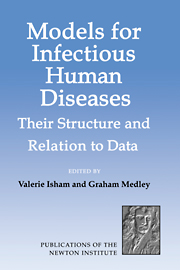Book contents
- Frontmatter
- Contents
- Introduction
- Participants
- Non-Participant Contributors
- Part 1 Transmissible diseases with long development times and vaccination strategies
- Part 2 Dynamics of immunity (development of disease within individuals)
- Evolutionary dynamics of HIV infections
- Statistical models for analysis of longitudinal, CD4 data
- Some mathematical and statistical issues in assessing the evidence for acquired immunity to schistosomiasis
- Virulence and transmissibility in P. falciparum malaria
- Invited Discussion
- Invited Discussion
- Invited Discussion
- Lifespan of human T lymphocytes
- Diversity and virulence thresholds in AIDS
- Statistical analysis of AZT effect on CD4 cell counts in HIV disease
- Modeling progression of HIV infection: staging and the Chicago MACS cohort
- The interpretation of immunoepidemiological data for helminth infections
- The distribution of malaria parasites in the mosquito vector: consequences for assessing infection intensity in the field
- When susceptible and infective human hosts are not equally attractive to mosquitoes: a generalisation of the Ross malaria model
- The dynamics of blood stage malaria: modelling strain specific and strain transcending immunity
- Part 3 Population heterogeneity (mixing)
- Part 4 Consequences of treatment interventions
- Part 5 Prediction
The distribution of malaria parasites in the mosquito vector: consequences for assessing infection intensity in the field
Published online by Cambridge University Press: 04 August 2010
- Frontmatter
- Contents
- Introduction
- Participants
- Non-Participant Contributors
- Part 1 Transmissible diseases with long development times and vaccination strategies
- Part 2 Dynamics of immunity (development of disease within individuals)
- Evolutionary dynamics of HIV infections
- Statistical models for analysis of longitudinal, CD4 data
- Some mathematical and statistical issues in assessing the evidence for acquired immunity to schistosomiasis
- Virulence and transmissibility in P. falciparum malaria
- Invited Discussion
- Invited Discussion
- Invited Discussion
- Lifespan of human T lymphocytes
- Diversity and virulence thresholds in AIDS
- Statistical analysis of AZT effect on CD4 cell counts in HIV disease
- Modeling progression of HIV infection: staging and the Chicago MACS cohort
- The interpretation of immunoepidemiological data for helminth infections
- The distribution of malaria parasites in the mosquito vector: consequences for assessing infection intensity in the field
- When susceptible and infective human hosts are not equally attractive to mosquitoes: a generalisation of the Ross malaria model
- The dynamics of blood stage malaria: modelling strain specific and strain transcending immunity
- Part 3 Population heterogeneity (mixing)
- Part 4 Consequences of treatment interventions
- Part 5 Prediction
Summary
The most common measures of mosquito infection with Plasmodium estimated in the field are the prevalence and intensity of malarial parasites. Of these quantities, the prevalence is the simplest to measure. We are interested in the effect of sample size (numbers of mosquitoes examined) on the accuracy of estimation of these quantities, and the relationship between the distribution of infectious stages within the mosquitoes and the population dynamics and genetics of malaria.
Previous work has shown that the distribution of malaria oocysts within their vector hosts is empirically well described by a negative binomial distribution with varying mean and overdispersion (Medley et al. 1993). Although this research was carried out on laboratory derived infections, the relationship appears consistent over a variety of malaria and vector species combinations. The implication is that the relationship is an intrinsic feature of the population biology of malaria parasites within their vectors.
In this presentation, we use data from wild caught mosquitoes (Anopheles gambiae s.L and A. funestus) infected with Plasmodium falciparum. There were a total of 1112 mosquitoes within 64 samples (mean 17.4 mosquitoes, range 2–60): each sample being the total number of mosquitoes caught in a household. The total number of oocysts found in the mosquitos was 960 (mean intensity within samples 1.34, range 0.023–24). For further details see Billingsley et al. (1994). The distribution of oocysts was found to be consistent with the laboratory derived infections, and no difference was detected between the distributions in the different vector species, further suggesting that the distribution is a conserved feature of the population biology of different parasite and host species.
- Type
- Chapter
- Information
- Models for Infectious Human DiseasesTheir Structure and Relation to Data, pp. 204 - 205Publisher: Cambridge University PressPrint publication year: 1996
- 1
- Cited by

